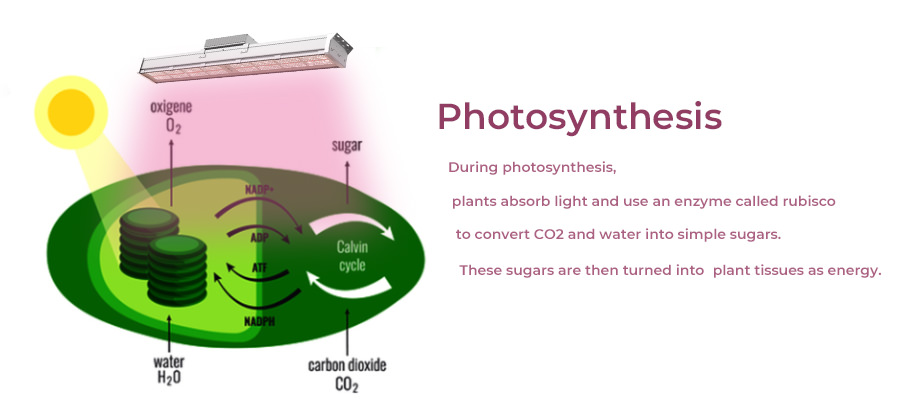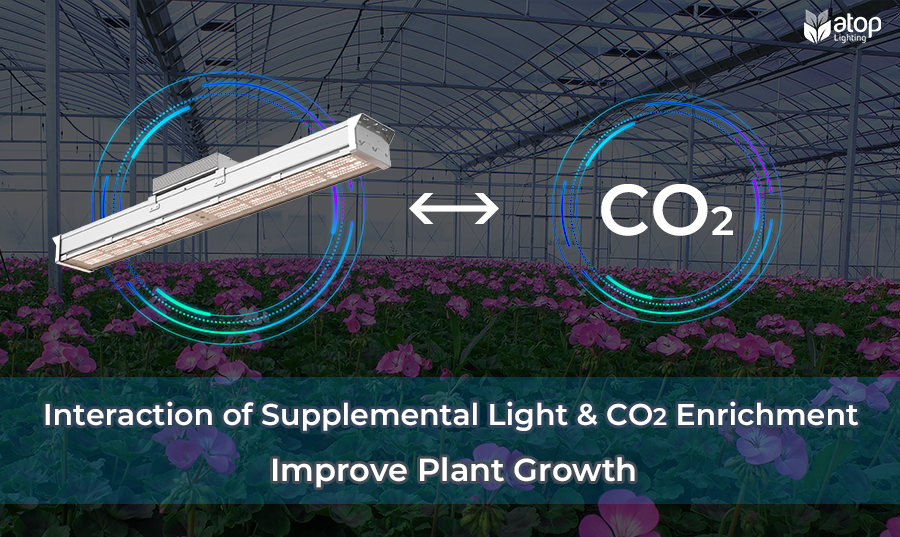Interaction of Supplemental Light and CO2 Enrichment Improve Plant Growth
In recent years, CEA is popular with indoor cultivation. Growers strive to provide optimal environment to improve growth, quality, and yield. Since light is the major source for photosynthesis, artificial grow lights are utilized in greenhouses and vertical farms to supplement light for plants. Artificial lights increase the resistance to bad weather, enabling plants absorb sufficient light in the winter or cloudy days. However, important factors for photosynthesis and plant growth are more than light. Water, CO2 (Carbon Dioxide), humidity, and nutrients are also critical. Even if under the optimal lighting condition, plant growth is limited due to the lack of water, CO2, or other growing factors. Unlike water and nutrients, CO2 is often ignored in indoor cultivation, in particular the tightly-sealed greenhouses. But CO2 is an indispensable component of photosynthesis. There are various studies focused on the individual effect of supplemental light or CO2 enrichment on plants, while few studies concentrated on their interactions. In fact, research shown interaction of supplemental light and CO2 enrichment improved plant growth. This post would like to talk about the effects of CO2 enrichment and supplemental lights on each other, as well as their interaction on plant growth.
Effects of CO2 enrichment
CO2 is the important component of photosynthesis. During photosynthesis, plants use an enzyme called rubisco to convert CO2 and water into simple sugars. These sugars are then turned into plant tissues as energy. Research shown that CO2 enrichment could increase the numbers of branches and leaves, and enlarge leaf area. It could also improve growth, quality, and yield.
CO2 enrichment has effect on light utilization. With increasing CO2 enrichment, light utilization of plants can be more efficient. Outdoor CO2 enrichment is about 300 ppm to 400 ppm. Though this enrichment range is negative to the environment, it can increase plant growth rapidly. But CO2 level is much lower than outdoor environment in a tightly-sealed greenhouse. It may be as low as 150 ppm in a greenhouse, which can slow growth significantly. A low CO2 enrichment will reduce the photosynthesis and the light saturation point. It means that plant cannot take advantage of the supplemental light, even if the light spectrum is optimal or light intensity is power enough. In contrast, increasing CO2 enrichment allows better light utilization up to the point of light saturation. Therefore, enriching the CO2 in a greenhouse enables plants utilize light more efficiently, increasing photosynthesis, and then boost plant growth. But we should avoid the overdone CO2 concentration. CO2 enrichment exceeds 1500 ppm is will damage plant growth.

Effect of supplemental lights
Light is the basic component for photosynthesis. It is well-known that light spectrum in PAR range (400 - 700nm) is beneficial to photosynthesis. The blue light improves plant growth while red light boosts flowering and fruiting. Supplemental lights enable plants keep growing no matter in the winter or cloudy days. Supplemental lights also allow advanced harvest and year-round production, which help growers reap more profits.
We have known that CO2 enrichment can affect utilization of supplemental light. Similarly, the selection of supplemental lights has effects on CO2 utilization. When it comes to photosynthesis, it is temperature driven. Higher temperature contributes to enrich CO2 then increase photosynthesis. This temperature refers to the leaf temperature, not the ambient temperature, because the process of CO2 conversion occurs inside the leaves. Generally, the leaf temperature is higher than ambient temperature. There are various supplemental lights on the market, fluorescent lights, HPS lights, and LED lights are the common supplemental lights used in indoor growing. Fluorescent lights produce less heat and even lighting. But they are costly as growers have to change them to meet the needs for different growing stages. HPS lights can cover a large area, but they have high energy consumption and heat emission. Over-heat can cause the evaporation, nutrient toxicities, and leaf burn. LED lights are replacing fluorescent lights and HPS due to their high efficiency, less energy consumption, low heat, and long lifespan. Although LED lights cannot generate as much heat as HPS light, they can be placed closer to plants without the risk of burning. Furthermore, since LED grow lights create less heat, they won’t cause the uneven temperature from the top of the canopy to the bottom. In contrast, LED lights produce a more uniform canopy. Looking for efficient and high quality LED grow lights? Contact us!
Interaction of supplemental light and CO2 enrichment
Supplemental lights and CO2 are essential for photosynthesis and plant growth. But both of them have limitation of signal usage. Supplemental lights cost tremendous electrical charges during the whole production of plants. If the environmental daily light integral is quite low, enriching CO2 can be more effective than adding supplemental light within certain limits. Especially in cold and winter days, CO2 enrichment in the greenhouse drops significantly due to the poor ventilation. This is because the greenhouse is closed to maintain the temperature, and there is little or even no fresh air. Increasing CO2 enrichment can enhance photosynthesis. From adding CO2 in the winter and spring, growers can reduce supplemental lighting. It also enables growers reduce cost because supplement CO2 is cheaper than supplemental lighting. As mentioned above, plants convert CO2 and water into simple sugars. But it can only happen in the presence of sunlight or artificial light. Light is primary energy for photosynthetic pigments to convert CO2 and water into simple sugars. Without supplemental lights, photosynthesis is limited. Besides, neither light intensity nor duration is adequate to plant growth. Thus, combining CO2 enrichment and supplemental lighting has positive effects on plant growth. Interacting supplemental light and CO2 enrichment significantly improve photosynthesis, plant growth, and yields. It is an economical metric for growers as well.
In conclusion, both supplemental light and CO2 enrichment play important roles in photosynthesis. Light is the irreducible source for photosynthesis. Plants absorb light and convert CO2 and water into simple sugars during the photosynthesis. Under low light conditions such as the winter, nighttime, and insufficient daily light integral, adding carbon dioxide concentration can help to improve the light saturation point and light utilization. Supplemental light and CO2 enrichment complement each other. Interacting supplemental light and CO2 enrichment is beneficial to photosynthesis, plant growth, flowering, fruiting, and yields.


